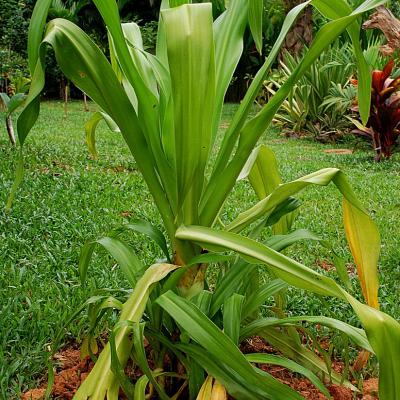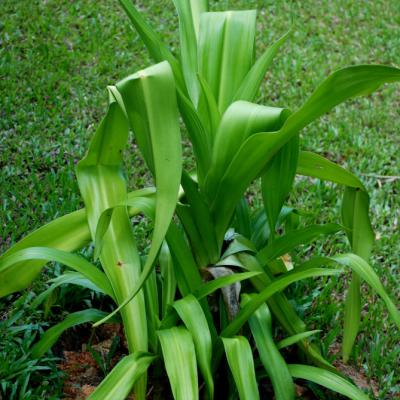Amaryllidaceae-Crinum-asiaticum
Classification
- Botanical Family : Amaryllidaceae
- Genus : Crinum
- Epithet : asiaticum
- German Family Name: Amaryllisgewächse
- English Name: Poison bulb, River lily, Spider lily
- Thai Name: พลับพลึงขาว
- Thai Phonetic: plap plüng kaau
- Author: L.
Water Requirements
Plant Type
Light Requirements
Cultivation
Crinum asiaticum is because of its size in itself an impressive plant in any garden. The evergreen plant is about 2.50 m hight. The dark green strap-like leaves can be more than 1 m long and 10 cm wide.
The flowers are white and mild fragrant and are arranged in clusters atop thick, succulent stems. Blooms all year round.
Crinum asiaticum is happy in just about any type of well drained soil.
For an abundant flowering a fully sunny location is preferred. Grows well in light shade.
Provide average water. Crinum asiaticum do well in dry soils and are fairly drought tolerant.
Crinum asiaticum does best planted in groups or as a speciemen. It looks very nice also with Hymenocallis littoralis at pond edges or on the banks of streams where the space alloud. The plants can stand there in the mud, but not in the water. As a container plant and in small gardens it is not suitable for its large size.
In this species there are some more variations: Variegatum (see further discription under Crinum asiaticum Variegatum) is a smaller plant with white stripes on the leaves. Sunray has yellow stripes, while Starstruck has yellow dots.
All parts of the plant are poisonous. The sap may cause skin irritation. It causes stomach discomfort if ingested.
Crinum asiaticum ist wegen seiner Größe allein schon eine imposante Erscheinung in jedem Garten. Die immergrüne Pflanze erreicht in seiner Höhe ca. 2,50 m. Die dunkelgrünen bandartigen Blätter können mehr als 1 m lang und 10 cm breit sein.
Die Blüten sind weiß, duften zart und sind in Büscheln am Ende von dicken, saftigen Stengeln angeordnet. Sie blühen das ganze Jahr hin durch.
Crinum asiaticum wächst in jeder gut durchlässigen Erde. Für eine reichliche Blütenbildung wird ein voll sonniger Standort bevorzugt. Gedeiht aber auch in hellem Halbschatten. Die Pflanze hat einen mittleren Wasserbedarf. Toleriert auch trockenere Böden und kurzzeitige Trockenheit.
Crinum asiaticum kommt am besten als freistehende Gruppe oder Einzelpflanze zur Geltung. Sie sieht aber auch zusammen mit Hymenocallis littoralis an Teichrändern oder am Ufer von Wasserläufen sehr hübsch aus, wenn es der Platz erlaubt. Die Pflanzen können dort im Morast stehen jedoch nicht im Wasser. Als Kübelpflanze und in schmalen Gärten ist sie auf Grund ihrer Größe nur bedingt geeignet.
In dieser Art gibt es noch einige Variationen: Variegatum (siehe Beschreibung dazu unter Crinum asiaticum Variegatum) ist eine kleinere Pflanze mit weißen Streifen auf den Blättern. Sunray hat gelbe Streifen, während Starstruck gelbe Punkte hat.
Alle Teile der Pflanze sind giftig. Der Saft kann Hautirretationen hervorrufen. Verursacht Magenverstimmung und Übelkeit, wenn die Pflanze verzehrt wird.
Origin
Miscelaneous
Ethnomedical uses
The ethnomedical information is provided for general information only, it is not intended as guidance for medicinal use.
In Southeast Asian countries, Crinum asiaticum has a considerable medicinal reputation as a potent folk medicine in the treatment of injury and inflamed joints. The plant has been used for cancer.
Indonesia: the oiled and heated leaves are useful to treat wounds by poisoned arrows, bites and stings.
Malaysia: poultices of the leaves are applied to swellings, swollen joints, lumbago, pains and in cases of headache and fever.
India: the leaves are applied to skin diseases and inflammation. The crushed leaves mixed with honey are applied to wounds and abscesses. Its seeds are considered purgative. (1)
(1) http://medicinalplants.us/crinum-asiaticum
Volksmedizinische Verwendung
Die Berichte über volksmedizinische Verwendung ist nur zur allgemeinen Information und nicht als medizinischer Ratgeber zu betrachten.
In südostasiatischen Ländern, hat Crinum asiaticum einen erheblichen medizinischen Ruf in der Volksmedizin bei der Behandlung von Verletzungen und entzündeten Gelenken. Die Pflanze wird bei Krebs eingesetzt.
Indonesien: die erhitzten Blätter werden eingesetzt, um Wunden, die durch vergiftete Pfeile, Bisse und Stiche entstanden sind, zu behandeln.
Malaysia: werden Umschläge aus den Blättern bei Schwellungen, geschwollenen Gelenken, Kreuzschmerzen, Kopfschmerzen und Fieber angewendet.
Indien: die Blätter werden bei Hauterkrankungen und Entzündungen angewendet. Die zerkleinerten Blätter werden mit Honig vermischt und auf Wunden und Abszessen verwendet. Die Samen werden als Abführmittel eingesetzt. (1)
(1) http://medicinalplants.us/crinum-asiaticum


